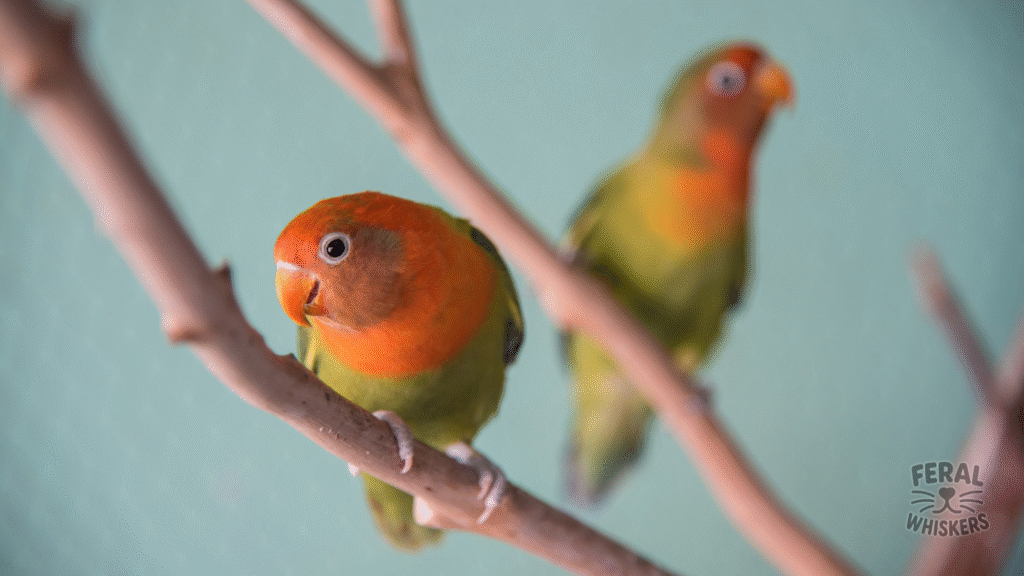Introduction: Little Birds With Big Hearts

Lovebirds, members of the genus Agapornis, are small parrots native to Africa and Madagascar. They’ve earned their name because of the strong bonds they form with their mates or humans. At just 5–7 inches long, lovebirds may be petite, but their personalities are bold, affectionate, and playful.
They are one of the most popular pet birds worldwide — perfect for owners who want a mix of color, personality, and companionship without the overwhelming size of larger parrots.
1. Personality: What Are Lovebirds Really Like?
- Affectionate: Known for close pair bonding. Single birds will often bond tightly with their human caregiver.
- Energetic: Lovebirds are busy explorers—always chewing, climbing, or playing.
- Bold: Don’t let the size fool you; these little parrots can be feisty and assertive.
- Vocal: They chirp and chatter rather than mimic speech clearly. They are not quiet birds, but their sound is less piercing than large parrots.
- Curious: They love investigating anything new and thrive when mentally stimulated.
Fun Fact: The name lovebird comes from their affectionate behavior—paired birds can spend hours preening one another or sitting side by side.
2. Lifespan
With good care, lovebirds can live 10–15 years, and some live up to 20 years. Taking one home is a serious long‑term commitment.
3. Diet: Fueling Their Energy
Lovebirds need a nutrient‑rich diet to stay healthy.
Ideal Diet Breakdown
- Pellets (60–70%): Choose small‑parrot pellets as a base.
- Fresh Vegetables (20%): Leafy greens, carrots, broccoli, bell peppers.
- Fruits (10%): Papaya, apple slices (seedless), berries, melon.
- Grains/Seeds (as treats): Sprouted seeds and millet sprays are excellent rewards.
- Fresh Water: Always available.
Foods to Avoid
Avocado, chocolate, coffee, alcohol, salty snacks, onions, garlic, rhubarb, fruit seeds, or pesticides on produce.
4. Housing and Environment
Cage Requirements
- Size: At least 24”L x 24”W x 24”H; lovebirds need space to fly.
- Bar Spacing: No more than ½” to prevent escapes or injury.
- Perches: Variety of textures (natural wood, rope).
- Toys: Chew toys, shreddables, and foraging setups to prevent boredom.
Out‑of‑Cage Time
- At least 2–4 hours daily of supervised playtime outside their cage.
Social Needs
- Lovebirds need daily interaction. Keeping them as singles can increase human bonding, while pairs may bond more closely to each other than to humans.
5. Training Lovebirds
While not the clearest talkers compared to African Greys, lovebirds are intelligent and learn simple tricks well.
Training Tips
- Step Up Command: Essential for handling. Train by holding a finger and gently encouraging them to hop on, rewarding with a treat.
- Recall Training: Call them by name while holding millet; reward when they fly to you.
- Tricks: Some learn spins, “wave,” or even target training.
- Patience is Key: Training sessions should be short (5 minutes) and fun.
Talking and Vocalization
- Lovebirds rarely talk as clearly as larger parrots, but some mimic simple words or sounds.
- Most are better whistlers and chirpers.
6. Health and Holistic Prevention
Common Health Issues
- Nutritional deficiencies: From seed‑only diets.
- Respiratory infections: From drafts, poor hygiene, or scented products.
- Feather plucking: Often stress or boredom related.
- Psittacosis (parrot fever): Zoonotic disease — requires urgent vet care.
Holistic Prevention
- Provide varied, balanced diet (pellets + fresh foods).
- Keep environment clean and toxin‑free (no Teflon pans, aerosols, smoke).
- Offer foraging toys and mental stimulation.
- Ensure daily interaction and bonding time.
- Maintain a consistent routine — lovebirds are comforted by predictability.
Signs of Illness to Watch For
- Fluffed up feathers all day.
- Increased sleeping, lethargy.
- Loss of appetite or weight.
- Change in droppings.
- Tail bobbing when breathing.
- Discharge from eyes or nostrils.
👉 If you see any of these, visit an avian veterinarian immediately.
7. Lovebirds as Pets: Is It Right for You?
YES, if you want:
- A small parrot with a big personality.
- Daily interaction and play time.
- A bird that is affectionate and curious.
MAYBE NOT, if you:
- Need a quiet pet — they are vocal.
- Don’t have time for at least 2–3 hours of socialization daily.
- Expect “talking” like larger parrots (it’s unlikely).
8. Fun Facts About Lovebirds
- There are nine recognized species of lovebirds, with the Peach‑faced, Fischer’s, and Masked lovebirds being most common as pets.
- In Africa, wild lovebirds nest in tree cavities, sometimes even termite mounds!
- Their pair bonding behavior symbolizes loyalty and love — hence their romantic name.
- Lovebirds are excellent chewers — without toys, they’ll shred your furniture or clothes!
9. FAQs
Q1: Do lovebirds need to be kept in pairs?
Not always. They thrive in pairs, but a single well‑socialized lovebird can bond strongly with humans.
Q2: Do they talk like parrots?
Not clearly. A few individuals may mimic words or whistles, but expect chirps more than speech.
Q3: How long do lovebirds live?
10–15 years on average, sometimes up to 20 with great care.
Q4: Are lovebirds cuddly?
Yes! They love sitting on shoulders and especially adore head scratches once bonded.
Q5: Do lovebirds bite?
They can. Like all parrots, they may nip when frightened, hormonal, or asserting dominance. Gentle training and trust‑building reduce biting.
Q6: How much does it cost to care for a lovebird?
Initial setup (cage, toys, food) can cost $200–400, with ongoing care around $30–50 per month (food, toys, vet visits).
Final Takeaway
Lovebirds are the perfect example of how “small doesn’t mean simple.” They need balanced diets, daily mental stimulation, and hours of social time — but in return, they give years of affection, joy, and companionship.
Whether you keep them in pairs or bond with a single bird, these colorful parrots will fill your home with energy and love.

